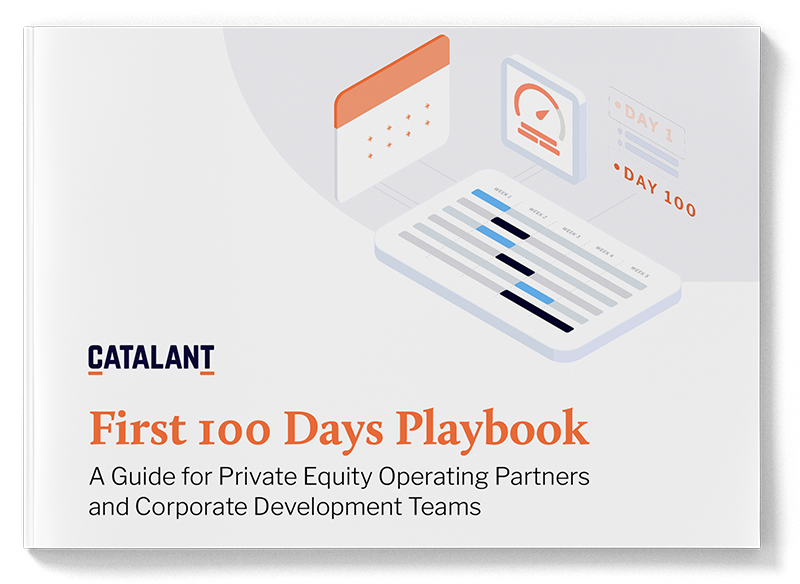FP&A Investment During the Private Equity Deal Cycle

This article is part of the latest issue of the Catalant Quarterly: “The ‘First 100 Days’ Strategy: A Blueprint for Accelerated Value Creation.” Read the issue here and download the First 100 Days Playbook.
The stand-up or expansion of the financial planning and analysis (FP&A) function is a common initiative following private equity transactions, or any investment of institutional capital. This is particularly true in investments or recapitalizations representing the first institutional capital into a business (e.g., in lower- to middle-market businesses between $1-25 million of EBITDA), where it is less likely for the organization to have dedicated FP&A professionals and a track record of institutional-grade data architecture, stakeholder reporting, business intelligence, budgeting, and forecasting.
Successful founder-led and family-owned companies make up the majority of this “first time” investable pool, with tenured management teams carrying significant institutional knowledge and intuitive feel for the ebbs and flows of the business. Investments into FP&A are critical to the effort of embedding this knowledge and intuition into the business itself, paving the path for succession to future leadership while mitigating key man risk.
When private equity transactions involve management transitions, FP&A investments become an absolute necessity for institutional investors to clear the runway for growth and other value creation efforts such as add-on acquisitions. If you’re a business owner reading this, note that making progress on these efforts before the deal serves as a tailwind for an efficient transaction process and value maximization. Private equity does not mind paying more for de-risked businesses that are turnkey for additional growth initiatives!
In the video below, you’ll find highlights of key takeaways from this article, in addition to pointing out what companies often get wrong in this process. Then, dive into more best practices throughout the remainder of this article.
This article highlights FP&A implementation do’s and do not’s, for private equity professionals and management teams alike, to grease the wheels for smooth FP&A initiatives. Across a wide variety of implementations and process improvement projects, we’ve experienced just about every pain point there is when it comes to FP&A initiatives. None of the below is binary or mutually exclusive – we aren’t claiming that certain things aren’t necessary, value-added, or should be prioritized over FP&A – though we are speaking to the risks within finance when FP&A is not considered or not at the table for the dialogue.
When to stand up an FP&A function in an investment
Private equity and other sponsors, typically spread across portfolios of investments, have heavy demands on information flow as they are at least one degree of separation from the day-to-day management of the underlying businesses. These demands include timely reporting of financial and operational performance, rolling forecasts of P&Ls and working capital/liquidity, and granular, credible budget builds that show management has sufficient visibility and can drive accountability throughout the organization. The focus on information flow starts during the diligence process, and establishing new or updated FP&A components often starts immediately upon transaction close and certainly within the “first 100 days.”
The stand-up or enhancement of the FP&A function is a meaningful, value-added effort and corresponding investment into the business. Therefore, nailing the implementation of the FP&A function and related improvements is a key part of the private equity playbook. Private equity firms and other sponsors should adopt an FP&A lens when overseeing changes elsewhere, particularly in accounting, to streamline the execution of this playbook chapter.
Data and FP&A roadmap readiness
A lower- to middle-market private equity transaction almost always means significant changes for the accounting and finance functions, including additional requirements, capabilities improvement, and/or new system implementations. Following a transaction event, there are often immediate priorities that influence the sequencing of finance initiatives, such as implementing a 13-week cash flow forecast in a newly-levered, no-longer-cash-rich business lacking a history of managing through more restrictive working capital conditions.
The sequencing of FP&A priorities, amidst potential changes in the data and system environment, can have a material impact on the overall FP&A implementation roadmap. Regardless of where you elect to start, private equity and portfolio company teams can ensure FP&A efficiency by focusing on the following:
- Identify the roadblocks. Before planning for change, vet whether you have data, process, and/or people problems in the context of reaching roadmap goals. Do not assume system change is a prerequisite for FP&A implementation or improvement. Particularly for organizations without dedicated FP&A professionals, there is almost always low-hanging process improvement fruit. Introducing the FP&A and data skillsets into the dialogue and environment is the first step to optimizing the FP&A roadmap, and remains true even when future system change is a given.
Systems only solve bottlenecks, not problems. Rushing to upgrade technology risks missing out on cross-functional requirements, while taking critical resources away from other priorities.
- Think central before thinking system. Efficient FP&A implementation requires establishing central sources of truth (CSTs) for critical information. Given the timing trade-off compared to system implementations and team adoption, creating manual and non-systematized CSTs, and controlled management thereof, can quickly advance FP&A implementation. When done well, CST exercises also have the benefit of informing future data capture needs and business requirements for system upgrades, all while not rendering implemented FP&A processes obsolete when any such upgrades are completed.
Setting the foundation for the entirety of the FP&A roadmap, including defining central sources of truth (CSTs), saves significant time and costs in FP&A implementation initiatives.
- Get foundational. Regardless of FP&A component sequencing, focusing in on data that will feed multiple processes provides a strong foundation to build upon. This means, even if you are starting with 13-week cash flow, invest the time in flushing out what is needed from general ledger data which will feed other reporting and forecasting components. Defining required transactional granularity, core mapping, and data transformation objectives for all of FP&A can save significant re-work and re-wiring versus developing each FP&A component in isolation.
Reporting & forecasting readiness
Every sponsor, in almost every lower- to middle-market situation, seeks a significant expansion of reporting and forecasting capabilities. A transaction also typically comes with additional stakeholder information requirements, such as lender reporting, not previously required.
The demands on information flow and different views for specific stakeholders fall primarily to FP&A (assuming there are FP&A resources in place!). Portfolio companies may be dealing with any number of new financial measures, including members of the “EBITDA family” such as Management Adjusted EBITDA, Credit Agreement EBITDA, or Pro-Forma Run-Rate Synergized EBITDA (not a fake one!). Add in other new needs such as allocation frameworks, and there is quite a list of items that need to be created, modeled, reconciled, and bridged. These are rarely fully accomplished natively within the accounting ledgers, even among the most sophisticated team and system environments.
Teams with the best intentions, acting under pressure to meet requests while simultaneously working to deliver material improvements, are at risk for damaging future reporting and forecasting implementation and quality if they are not mindful of the impact of their actions on FP&A. Teams can mitigate these risks through the following considerations:
- Stray from the QoE gospel at your own peril. Many companies, following a private equity transaction, will leverage the quality of earnings (QoE) analysis as the source for historical financials versus internal accounting data. This is due to GAAP-/DD-related adjustments (a.k.a., corrected accounting) determined during the QoE initiative, the call out of QoE results in credit agreements (“Stipulated EBITDA”), and potentially other analyses around the sponsor’s preferred view of organizing financial data for go-forward management (segment breakouts, allocations, etc.). When companies immediately embark on historical clean-up, changes to the chart of accounts, and other accounting changes, any failure to preserve a clean bridge to the QoE creates time-consuming, banging-heads-against-the-wall reconciliation and bridging efforts that slow down and increase the costs of FP&A implementation.
Cleaning up legacy accounting data may be valuable, but should be approached purposefully and carefully bridged back to prior source data to avoid disruption to FP&A implementations.
- Completeness and consistency trump GAAP compliance. Getting accounting data and related processes to the right place, and auditable under GAAP, are critical initiatives and often non-negotiable requirements. However, for FP&A implementation, data completeness often has more value than GAAP compliance. For reporting and forecasting initiatives, improving the quality of data through class/dimensional tagging (e.g., fully-populated at the transactional level with consistent nomenclature) provides immediate FP&A ROI in isolating and analyzing trends. There is also the ancillary benefit of data completeness making subsequent accounting and other clean-up more efficient by capturing more on the first pass through.
The trend is your friend, if you can trust it. Prioritizing “data completeness” within historical data accelerates the value of FP&A implementation, while benefiting other initiatives. Help FP&A help you!
- Consider modeled overlays over accounting process changes. New owners and finance leadership often seek to view a business through improved and alternative lenses. Allocation frameworks are a primary example. While it is best for such frameworks to eventually make their way into underlying source data (i.e., removing one or more steps from source data to outputs), accounting change management takes time and may require additional resources. When led by FP&A, modeled overlays can be incorporated into reporting and forecasting tools, and this approach allows for easier iteration (changes are common!) versus deleting and replacing accounting source data multiple times.
Conclusion
FP&A implementation and improvements are high-value priorities, benefitting management teams and investment sponsors alike. However, progress and efforts elsewhere can have a material impact on the FP&A roadmap, the quality of components, and the time and costs for implementation. We hope the lessons and scars earned across dozens of FP&A implementations will assist you in prioritizing your FP&A dialogue and the successful execution of corresponding roadmaps.
Meet the Author

Benjamin Lehrer is the CEO of First Water Finance, the finance advancement platform serving finance leaders, business owners, and capital partners through FP&A, Corporate Finance, and Community. The First Water team has worked alongside more than 100 management teams and sponsors, with an emphasis on FP&A implementation and ongoing BPO support through First Water Managed FP&A SolutionsSM. Ben is also the Head of Learning & Development for The CFO Alliance, the premier finance leader peer group community, which has led more than 600 peer group and learning events and served nearly 10,000 finance leaders since inception.
Want to work directly with Benjamin and the First Water Finance team? Contact us to learn how.

Download the First 100 Days Playbook
Learn more about why the first 100 days after a transaction so important.